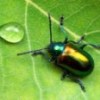
Urbana, Illinois
Easily mistaken for a bee, Eristalis is in fact a clever mimic capable of luring many an unsuspecting observer into the land of amusing taxonomy fail.
But the structure of the antennae, the broad attachment of the abdomen to the thorax, and the presence of only a single pair of wings mark it as a fly.
I took this photo in bright sunlight, although it doesn't look that way from the black backdrop. This dramatic lighting effect is achieved by using such a small aperture (f/13) and a fast shutter speed (1/250 sec) that almost no ambient light reaches the sensor. A small but intense flash directed at just the fly and the flower- but not the garden in the background- provides sufficient illumination for a proper exposure of just the intended subject.
photo details: Canon EOS 7D camera
Canon MP-E 65mm 1-5x macro lens
ISO 100, f/13, 1/250 sec

Nice photo, as always! How did you manage that without it buzzing off on you? Hehe.
That's certainly the hard part of shooting flies. One flash and they're gone!
True story:
Back in the early '80s I'm taking a entomology course. This week, the subject is "bee mimics". It's Thursday; fourth day of the Dips unit. I'm looking thru a binoc scope at a "Bombyliid" (stoned, as usual in those times) and I notice that it has four wings. Narrow waist. Triangular head with geniculate antennae. Tibial scopa. I look up. Just at that moment, the professor is walking by. I say "What's this bee doing in your fly collection?" (He gives me the derisive snort.) I say "It's got four wings." He pauses, sits, looks thru the scope. Sits up. Looks at me. Looks thru the scope again. Walks to the front of the class and announces: "Specimen X, labelled as a Bombyliid, is actually a bee." The other students gawk at me. I say "It's a bee that mimics bee mimics." Several students later confessed to me that they had also thought it was a bee. Years later, that professor was instrumental in getting me into grad school, despite my stoner GPA (I still haven't figured out whether I should thank him).
D.J. Lactin. Ph.D., Entomology.
The other students gawk at me. I say "It's a bee that mimics bee mimics.
Hello Alex,
It seems that i would be getting awesome information from your blog. It is really very exciting for me. The above pic of drone is really very beautiful.
Great photo and story. Thank you. btw im a bug photographer and researcher. following your blog.
Hey just read the article. I live in Lexington NC and have stumbled across an old tub full of the drone fly larvae. Need i say it is dead of winter here and they are very active right now. Crazy huh?